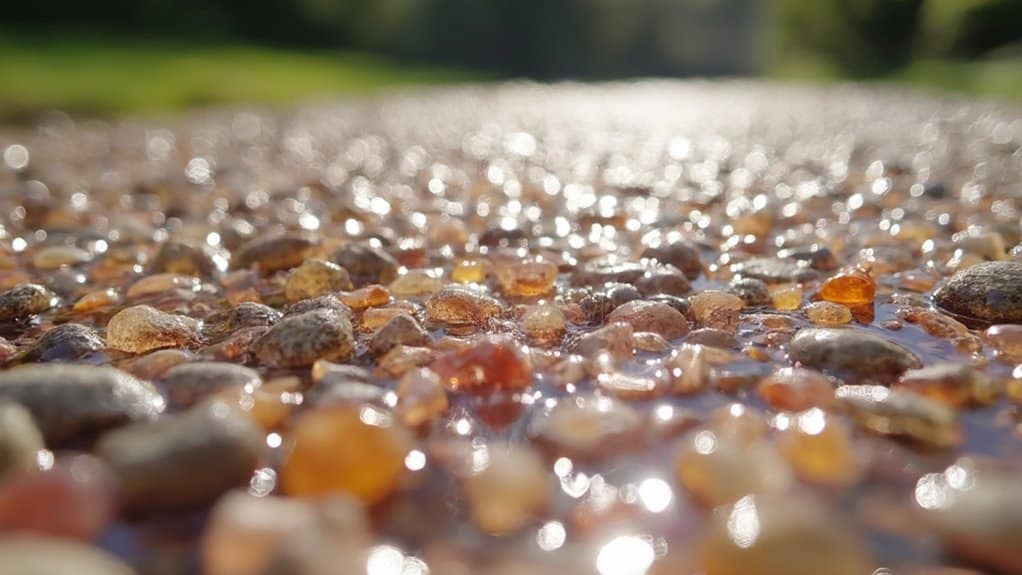The ideal thickness for resin-bound gravel varies by usage. Footpaths require a 15mm minimum for safe pedestrian use – think of a typical garden path or patio area. Driveways need 18mm to handle cars and regular vehicle movement, whilst cycling paths demand 20mm thickness. For commercial areas or spots with lorries and heavy vehicles, opt for at least 22mm. Getting the right thickness is crucial – too thin and it won't last, too thick and you're wasting materials. Choose based on your specific needs, whether it's a simple garden walkway or a busy shop car park.
Key Takeaways
The recommended thickness for resin-bound gravel varies by usage:
Footpaths: 15mm minimum ensures safe pedestrian use, much like the depth of a pound coin.
Driveways: 18mm minimum handles daily car movements without cracking or shifting.
Cycle paths: 20mm thickness withstands regular bike and occasional vehicle traffic.
Commercial areas: 22mm minimum copes with frequent vehicle movement and heavy foot traffic, ideal for shop fronts and car parks.
Tree pits: 40mm provides essential protection for tree roots whilst allowing proper water drainage.
Understanding Resin-Bound Gravel
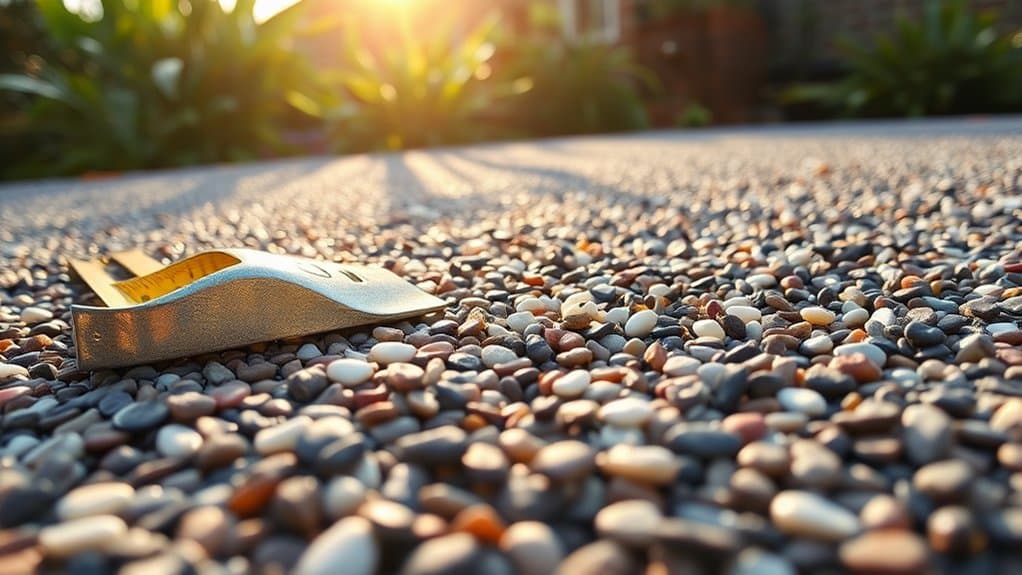
Resin-bound gravel combines smooth marble stones with tough resin to create a durable surface perfect for driveways and paths. Think of it like thousands of small stones held together by a strong glue, creating a surface that's both attractive and practical. The material stands up well to British weather, resists fading from sunlight and won't crack under normal use. Additionally, its resistance to impact ensures that it can withstand the wear and tear of everyday use without compromising its integrity. Proper installation techniques, such as ensuring a solid base, are crucial for maximizing the lifespan of the driveway. Once mixed and laid, the surface allows rainwater to drain through naturally, which helps prevent those annoying puddles we're all too familiar with in British weather.
Popular for both domestic and commercial projects, from garden paths to shopping centre walkways, resin-bound gravel offers the best of both worlds: it looks smart and does the job properly. It's particularly useful for front drives where you want something that looks better than plain concrete but doesn't require constant maintenance like loose gravel does.
Recommended Thickness for Different Applications
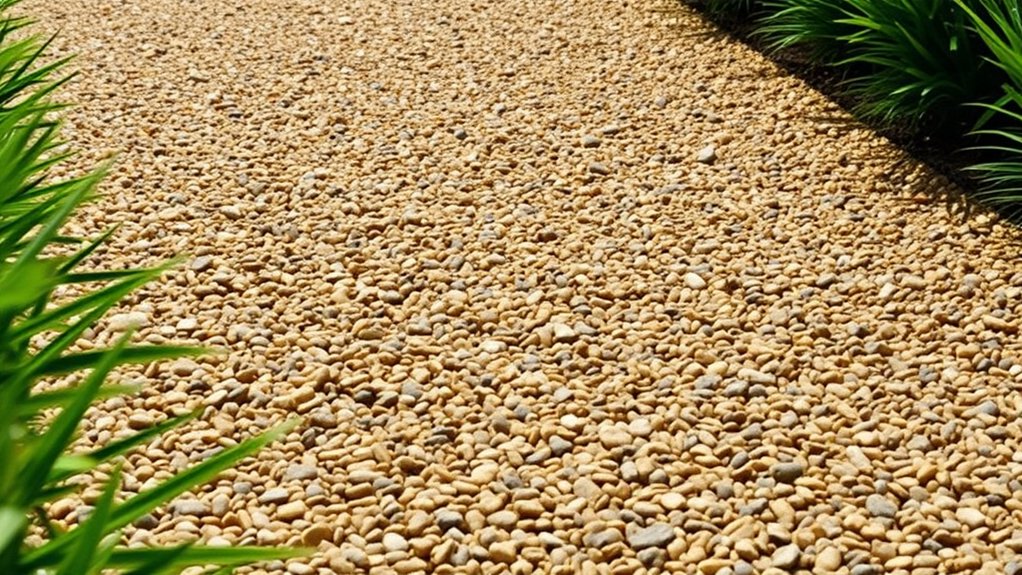
Resin-bound gravel thickness varies based on its use.
For standard footpaths, 15mm works perfectly with smaller stones, letting rainwater drain through naturally. This is essential because the permeable qualities of resin bound paving help reduce surface water run-off.
Commercial spaces need a tougher 22mm layer to handle constant foot traffic.
Cyclists require 20mm thickness for their lanes, whilst car parks must have 22mm to cope with vehicle weight.
Home patios do well with 15mm, giving a smart finish with finer stones.
Tree pits need the thickest layer at 40mm minimum, giving roots proper space to grow whilst keeping the surface intact.
Driveways: Ideal Thickness Specifications
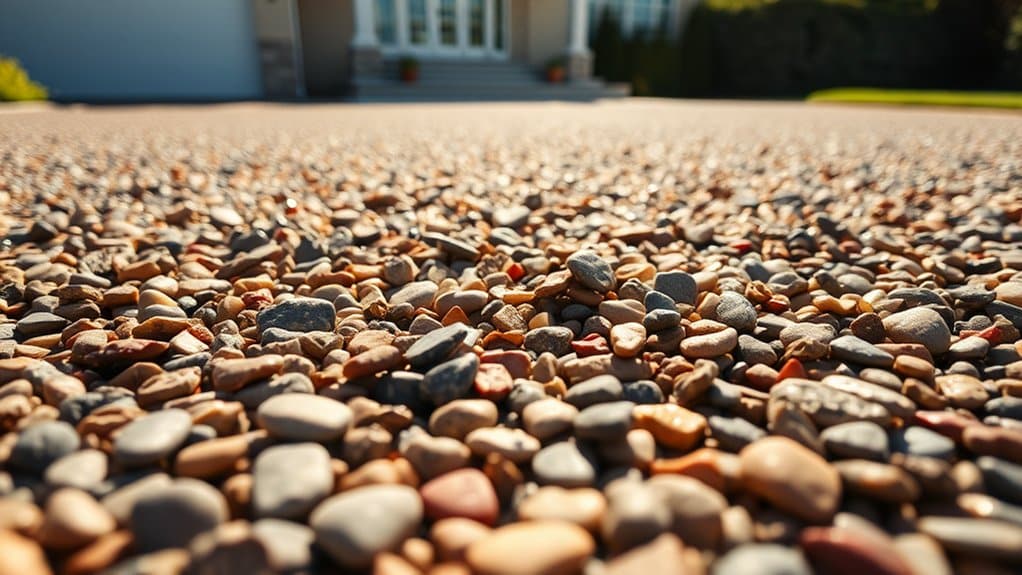
Driveways need proper thickness to withstand regular car traffic and British weather. For resin-bound surfaces, an 18mm depth is the bare minimum for day-to-day use.
Think of it like laying a carpet – too thin and it won't last, too thick and you're wasting materials. A depth under 16mm could lead to structural vulnerabilities and affect the longevity of your driveway.
The base layer is crucial – it must be at least 100mm deep and properly compacted. For perspective, that's about the height of a standard kerb.
If you're expecting heavy vehicles, like delivery vans or caravans, go thicker with the resin layer.
When choosing your aggregate size, follow this simple rule: make the overall thickness three times larger than your biggest stone.
So, if you're using 6mm stones, aim for at least 18mm thickness. A properly installed driveway with the right thickness will serve you well for years, saving money on repairs and maintenance down the line. Additionally, standard minimum thickness ensures durability and longevity, making it a crucial aspect of your driveway's design.
Footpaths: Thickness Considerations

The correct thickness of footpaths is crucial for long-term performance. Most UK installations require a minimum depth of 15mm to ensure safe pedestrian use. This depth should be at least three times the size of your largest aggregate – typically using a mix of 1-3mm and 2-5mm stones bound with roughly 7% resin.
A solid foundation of concrete or macadam is vital for lasting results, much like building a house on proper foundations. When laid correctly, the surface remains even and looks smart, whilst allowing rainwater to drain through naturally, helping prevent puddles and surface flooding. It is important to be mindful of weather conditions during installation, as they can significantly affect the curing and durability of the resin-bound surface.
Think of the layers like a sandwich – the stronger your base and the more evenly you spread your top layer, the better it holds together.
Getting these basics right means your footpath will serve its purpose and look good for years.
Commercial Areas: Heavy Traffic Requirements
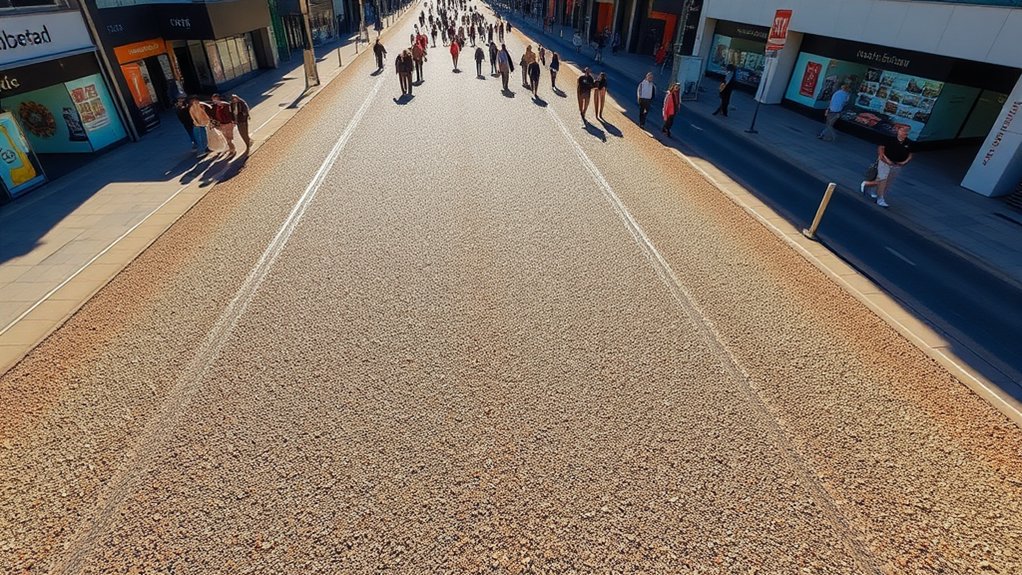
The correct resin-bound thickness for commercial spaces must withstand constant heavy traffic. For these high-wear areas, a 22mm depth proves ideal – much like the thickness needed for a busy supermarket car park or shopping centre entrance.
The surface requires proper installation over a solid base, typically concrete or tarmac, to prevent damage from regular vehicle movement and footfall. Think of it as building a proper foundation for a house – skimp on the basics, and problems quickly develop.
A robust base and correct depth work together to stop common issues such as surface cracking or movement, ensuring your commercial space remains serviceable for years to come.
Recommended Thickness Specifications
Thickness Guide for UK Installations
| Thickness (mm) | Suitable Use |
|---|---|
| 22 | High-traffic areas like car parks and driveways |
| 20 | Light vehicle areas such as home drives |
| 18 | Walkways and garden paths |
Choose aggregate size at least three times larger than the biggest particle. A permeable sub-base, such as MOT Type 1, ensures proper drainage, meets SuDS requirements and extends surface life.
Load-Bearing Capacity Considerations
The load-bearing strength of resin-bound surfaces matters greatly, particularly in busy commercial spaces.
To handle heavy vehicles, the surface needs a minimum 25mm thickness. Think of it like spreading weight across a sheet of ice – even distribution prevents weak spots and cracking.
When fitted properly, these surfaces can withstand up to 400 tonnes per square centimetre, roughly the weight of a small passenger jet. Quality aggregates and resins are crucial – much like choosing strong building blocks for a house.
A solid sub-base underneath acts as the foundation, boosting the surface's ability to handle heavy loads day after day. This combination is especially vital in high-traffic areas like car parks or loading bays.
Base Preparation Guidelines
Essential Base Preparation for Resin-Bound Gravel
Proper base preparation ensures resin-bound gravel surfaces last longer and perform better in high-traffic commercial areas. A well-built base layer provides stability and manages water drainage effectively.
| Requirement | Details |
|---|---|
| Depth and Material | Minimum 100mm, using MOT Type 3 hardcore |
| Compaction | Essential at every stage to prevent sinking |
| Moisture Control | Base must be completely dry before laying resin |
| Cleaning Procedures | Remove all debris with pressure washing |
| Surface Leveling | Repair any holes and cracks for a level finish |
Think of the base as the foundation of a house – get it right, and everything else falls into place. Skip the proper preparation, and you'll likely face problems like puddles, dips and cracks within months.
Cycle Lanes: Thickness Similar to Driveways
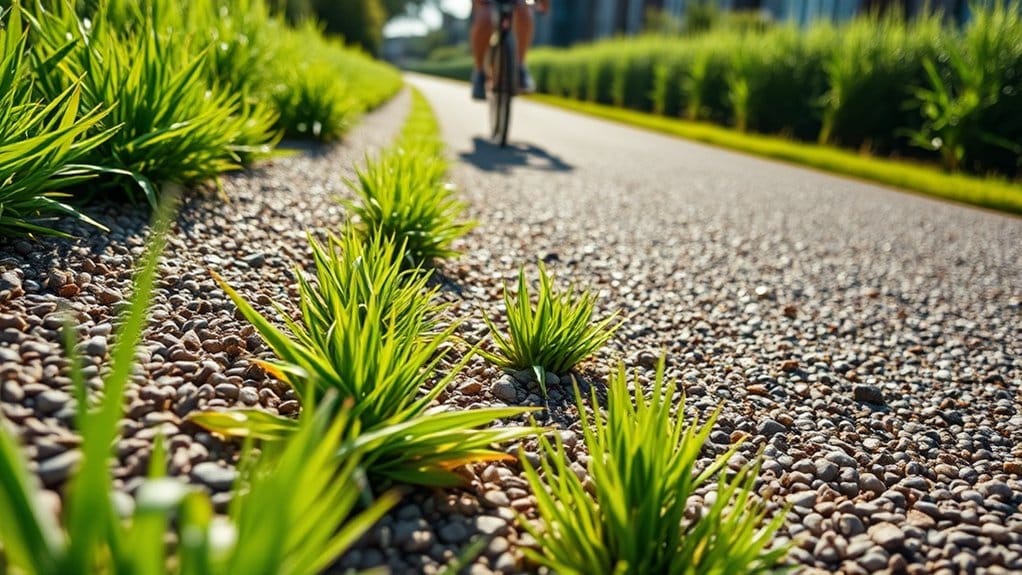
Cycle lanes require similar thickness to driveways to handle both bikes and occasional vehicle traffic. A 20mm depth meets standard specifications, ensuring the surface can withstand both uses without breaking down. This matches the minimum depth typically used for driveways across the UK, helping the lanes last longer and resist daily wear.
Using quality stone aggregates between 1-3mm or 2-5mm makes the surface stronger and less slippery in wet conditions. When laid over a permeable base, the surface meets Sustainable Drainage Systems (SuDS) requirements, managing rainwater effectively whilst supporting sustainable urban transport.
The design not only serves cyclists but also proves practical when vehicles need to cross, such as for maintenance or emergency access. This dual-purpose approach makes efficient use of materials and space in urban areas.
Tree Pits: Specialized Thickness Needs

Tree pit thickness directly affects root protection and tree health. Standard depths range from 25mm in pedestrian areas to 75mm where heavy foot traffic occurs.
Different settings require specific measurements:
- Light footfall (park paths): 25-30mm
- Moderate use (high streets): 40-50mm
- Heavy use (town centres): 60-75mm
The right thickness helps prevent soil compaction and protects vital root systems whilst maintaining a level surface.
For best results, match the depth to your location's specific needs and expected usage patterns.
Root Protection Requirements
Protecting Tree Roots
The right depth of resin-bound gravel in tree pits is crucial for tree survival and growth. For paths and walkways, a 50mm layer works well, whilst areas where cars drive need 75mm. Using larger stones (6-10mm) helps rainwater reach the roots properly.
| Usage | Required Depth | Stone Size |
|---|---|---|
| Paths and Walkways | 50mm | 6-10mm |
| Vehicle Areas | 75mm | 6-10mm |
| Environmental Benefit | High | Water-permeable |
Getting these measurements right keeps trees healthy and helps create greener towns and cities. Think of it as giving trees a proper breathing space – much like we need room to stretch our legs.
Installation Thickness Variations
Tree pits need specific depths that vary from standard uses, mainly to safeguard root systems. Use 50mm depth for pedestrian areas and 75mm where vehicles might occasionally pass.
Coarser 6-10mm aggregates work best for drainage, helping trees thrive whilst reducing soil wash-away. Get the basics right: lay a solid foundation using clean, compacted urban tree soil.
Concrete edging keeps everything in place and maintains the pit's shape. A properly built tree pit not only looks good but supports local wildlife.
For best results, seek expert advice on installation.
Importance of Base Preparation
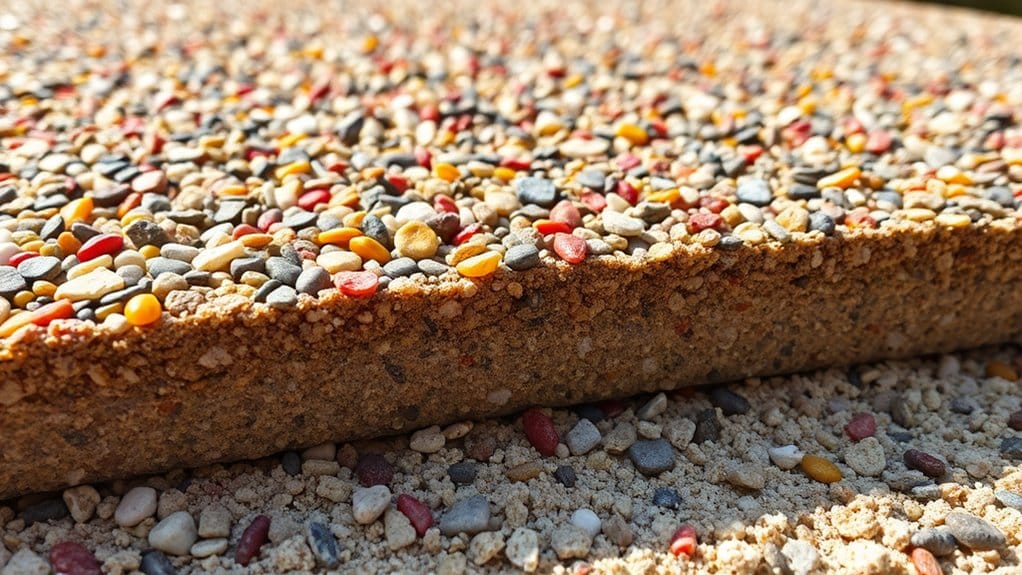
Base Preparation: Essential Steps
Skipping proper base preparation risks serious problems with your resin-bound gravel surface. A solid foundation ensures stability and proper water drainage – both crucial for lasting results.
Key steps:
- Check the surface for damage and loose material
- Power-wash the entire area thoroughly
- Repair any cracks or potholes
- Use primer where needed for stronger bonding
- Ensure the base is properly levelled
Think of it like painting a wall – just as you wouldn't skip sanding and priming, the same care is needed for your resin surface.
The strength of your finished surface depends entirely on what lies beneath.
Selecting the Right Aggregate Size
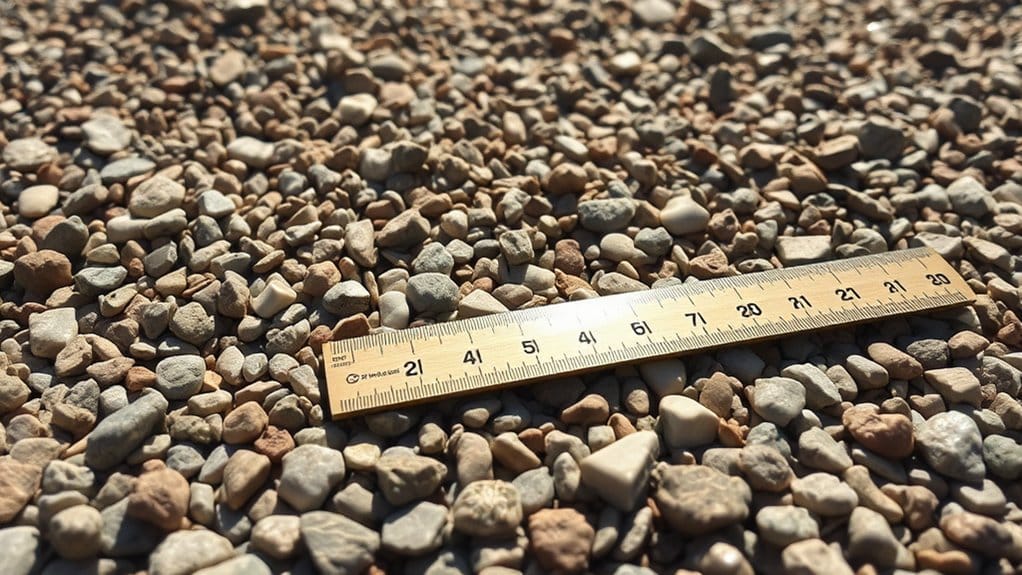
Selecting the Right Aggregate Size
The right aggregate size is crucial for a sturdy resin-bound gravel surface. The most popular sizes in the UK, 1-3mm and 2-5mm, deliver both strength and visual appeal. Combining different sizes creates a robust surface whilst reducing the amount of resin needed.
| Aggregate Size | Strength Benefits | Texture Options |
|---|---|---|
| 1-3mm | Lower resin usage | Smoother finish |
| 2-5mm | Better durability | Traditional gravel look |
| Mixed Sizes | Maximum strength | Varied texture |
| Larger Sizes | Higher load bearing | Non-slip grip |
| Smaller Sizes | Better drainage | Finer finish |
For a typical domestic driveway, 1-3mm offers an ideal balance, much like the finish you'd see at a modern housing development. For heavier-use areas like car parks, 2-5mm proves more suitable. Your choice affects both practical performance and overall look, so consider both aspects carefully.
Installation Best Practices for Even Depth
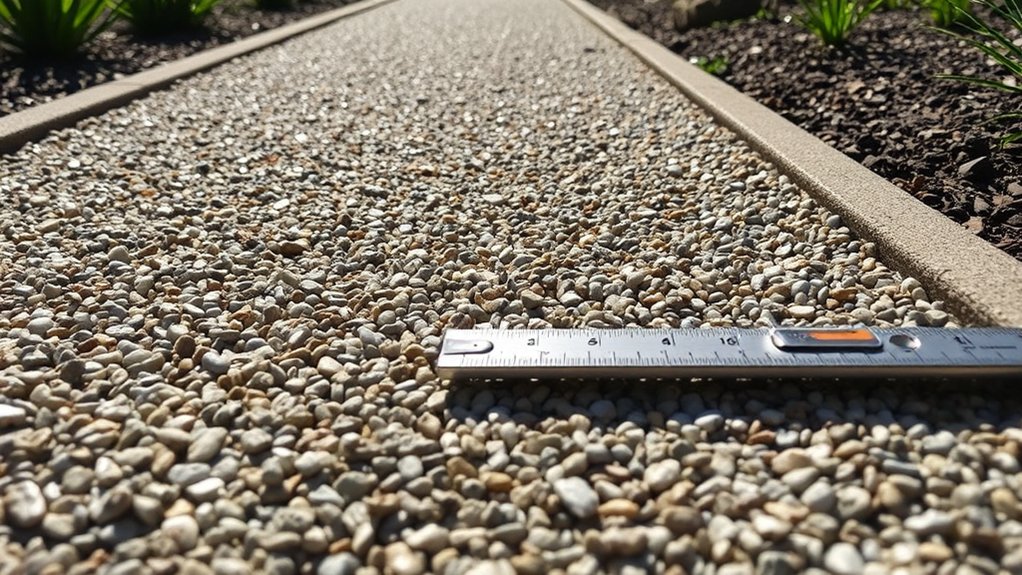
Achieving consistent depth is vital when installing resin-bound gravel. An even layer prevents weak spots and ensures the surface can handle everyday use, from parked cars to foot traffic.
Whilst DIY installation is possible, professional contractors bring the right tools and know-how to achieve uniform depth throughout, saving time and reducing the risk of costly mistakes.
A properly levelled surface not only looks better but also drains properly and lasts longer – making it a sound investment for your property.
Importance of Even Layering
Even Layering for Resin-Bound Gravel
Proper layering makes or breaks a resin-bound gravel installation. A uniform surface not only looks better but lasts longer and drains properly. Follow these essential steps for best results:
- Mix resin and aggregate exactly as specified (typically 1:10 ratio)
- Use steady, consistent trowel strokes from edge to edge
- Check depth with a gauge every few metres whilst laying
- Work in dry conditions between 5-25°C
- Sweep and pressure-wash the base thoroughly beforehand
A well-laid surface should feel firm underfoot with no obvious dips or raised areas.
Most domestic installations need a 15-18mm depth for driveways and 12-15mm for paths.
Professional Installation Benefits
Professional Installation: Why It Matters
Whilst DIY resin-bound gravel installation might seem tempting, professional fitting offers key benefits for your property's long-term value. Skilled installers ensure precise depth control and proper surface preparation, resulting in a more durable finish.
| Benefit | Professional Installation | DIY Installation |
|---|---|---|
| Reduced Maintenance | Yes | Limited |
| Increased Longevity | Yes | Potentially No |
| Enhanced Durability | Yes | Risk of Damage |
| Compliance with Regs | Yes | Risk of Violation |
Expert installation typically proves cost-effective, helping avoid common DIY pitfalls like uneven surfaces or improper mixing ratios. For instance, professionals understand local drainage requirements and ensure your surface meets all British building regulations.
The investment in professional fitting ultimately delivers better value through reduced maintenance needs and a longer-lasting, properly installed surface.
Maintenance and Longevity of Resin-Bound Gravel
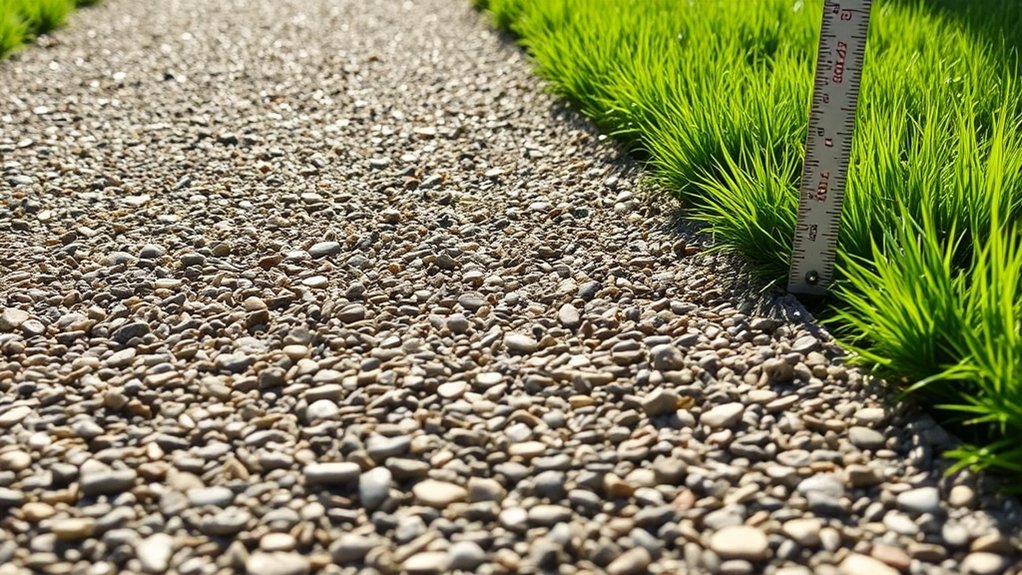
Maintaining Resin-Bound Gravel Surfaces
Regular maintenance ensures your resin-bound gravel stays durable and looks smart for years to come.
Essential care tips:
- Regular Clean: Brush weekly and jet-wash every few months, just as you'd a patio.
- Clear Leaves and Debris: Keep the surface clear to maintain proper drainage, especially during autumn.
- Tackle Weeds: Apply environmentally-friendly weed treatments when needed.
- Deal with Spills: Clean oil, fuel or wine straightaway to prevent permanent marks.
- Mind Your Driving: Avoid sharp steering in hot weather, as car tyres can leave marks when temperatures soar.
The surface should last 15-20 years when properly maintained – about the same as a well-kept block paving.
Frequently Asked Questions
Can Resin-Bound Gravel Be Installed in Cold Weather?
Resin-bound gravel installation is possible in cold weather, though you'll need to mind the temperature's impact on curing time. Ensure your base is completely dry – much like waiting for your patio to dry after rain before painting it. Moisture is your biggest enemy during installation, as it can affect the bond and leave you with a dodgy finish.
How Long Does the Resin-Bound Gravel Last?
Resin-bound gravel driveways, when properly laid, typically last between 10-25 years – roughly the span of a family estate car's lifetime. The surface remains durable and attractive throughout its lifespan, making it a worthwhile long-term investment for UK homeowners.
Is Resin-Bound Gravel Suitable for Sloped Surfaces?
Resin-bound gravel works well on slopes, much like you'd see on a typical British driveway. The key is proper drainage and expert installation. Think of it as laying a permeable coat that grips the slope whilst allowing rainwater to flow through naturally. A skilled contractor will ensure the right gradient – typically 1:60 – to prevent water pooling and maintain stability. Just ensure you're using a qualified installer who understands British weather conditions.
Can I Install Resin-Bound Gravel Over Existing Surfaces?
A proper base is essential for resin-bound gravel installations. Whilst you can lay it over existing concrete or tarmac, these surfaces must be stable, clean and crack-free. Check for damage, clear all debris and repair any issues before installation. A solid foundation ensures your resin surface stays level and durable for years to come.
What Colors Are Available for Resin-Bound Gravel?
A broad range of colours is available for resin-bound gravel, from classic gold and white to jet black. Mixing different shades creates striking effects, much like choosing paint colours for your home. Quality resins maintain their colour well against British weather and daily use, making them a practical choice for driveways and garden paths.
Conclusion
The right thickness of resin-bound gravel is crucial for long-term performance. For driveways that handle regular vehicle traffic, a 18mm depth is standard, whilst pedestrian areas like paths and patios can work well at 15mm. Commercial spaces typically need 20mm or more to cope with heavier use.
Getting the thickness right matters more than aesthetics – too thin and the surface may crack, too thick and you'll waste materials and money. The key is proper ground preparation, including a solid sub-base that's at least 150mm deep. Think of it like building a house – the foundations matter as much as what's visible on top.
Popular UK applications:
- Driveways: 18mm
- Paths and patios: 15mm
- Commercial areas: 20mm+
- Tree pits: 30mm+
These measurements assume you're using the correct aggregate size and resin mix for each project.
